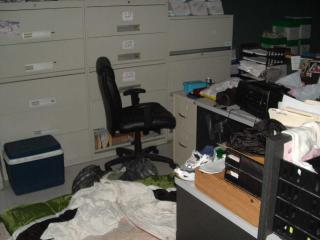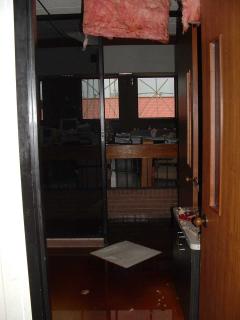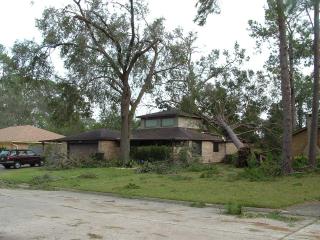It didn't matter that an army of thousands of power line workers, debris cleaners, tree-removal specialists and building contractors had moved through Beaumont like the house-cleaning Cat in the Hat with a monstrous three-handled family whatchamahoozit.
It didn't matter that I'd spent hours and hours inside and outside our house, superscrubbing counters, power sweeping floors and humping a ton of debris from around the yard to the curb.
Even after more than two weeks of Hurricane Rita cleanup, my wife still fell into silent shock as she moved through the house last night after I fetched her and the kids from the Houston airport.
You want to check out the yard?
"No," she said. "I need to pace myself."
A certain sense of violation has set in, thanks to a 100-foot pine tree that decided to engage in a jousting match with our roof. The crash impact was so great that it left wall hangings askew all over the house.
I'm glad I wasn't here for that.
"It's much worse than I expected," my wife finally said. About a week ago, from Virginia, where she had fled to her parents' house, she looked at the photos below in this blog and commented that "it didn't look so bad."
But photos of destruction, debris piles and victims' dumbfounded looks don't do justice to the landscape.
My wife's sense of shock has been shared by thousands of others who fled the storm, saw the aftermath images in newspapers and on television, and felt that maybe it wasn't so bad.
And then they returned home.
Friends and loved ones outside the damage bubble have presented an interesting stress dynamic for those who have been here and working long hours in the days following Rita's onslaught Sept. 23-24.
The spouses of several of our reporters made it clear that evacuation was the only option. Two of them has yet to return to work, while others returned and got busy after convincing their significant others that they had a job to do.
With the deadline pot boiling over one day last week, one reporter, frantically trying to finish a story, got a long-distance call from his wife. I overheard an amusing piece of the conversation, which went something like this:
Reporter: Baby, I'm on deadline right now.
Wife: %$#@!@!!!
Reporter: I know, baby, but I've really got to finish this story right now.
Wife: $%$#@!! OIL CHANGE!!! %$#@!!!!
Reporter: Baby, I know you can do this. I know you can get an oil change for the car all by yourself. It's not that hard.
Wife: YOU DON'T KNOW WHAT I'M GOING THROUGH!! $#$#@!!!! Aaaaaaaaaah!!!!
Reporter: Look, baby, I love you. I've really got to go. I'll call you back in a little while. I love you, baby.
A day or two after the storm, I answered a ringing phone in our swampy makeshift newsroom, and on the other end was the wife of another staff member. Calling from a comfy hotel up north, she wanted to know how her husband was doing. She asked me to tell it too her straight. I lied and said he was doing great but taking a nap. She didn't want to disturb him, so she picked me for venting, and my ear sustained a Category 5 rant for 10 or 15 minutes. I've since put in a FEMA application for catastrophic ear repair.
I was glad I could be there to listen, although I can't recall anything she said. She sounded like a cross between Charlie Brown's teacher and a livestock auctioneer.
That same day, the husband of one of our more tireless reporters showed up in the newspaper lobby, stabbed the air with his index finger and said, "I'm holding you responsible for her. Do you understand me?"
I did, but I also knew this reporter was quite capable of taking car of herself. Days later, I practically had to call in the National Guard to force her to take a day off. I like this brand of journalist. Clock watchers and timecard punchers need not apply.
To some, a journalist's work in a disaster zone seems unnecessary compared with the duties that fall upon the shoulders of police, firefighters, medical personnel and other soldiers in a hurricane aftermath.
What they don't understand is that the media is the primary means for spreading information, whether it be where fresh water, ice, gasoline and food can be found to warning evacuees that coming home is a very bad idea. In regard to the latter, many did not listen. They came home, found the city uninhabitable and quickly left.
In addition, a true journalist wants to be nowhere else than in the middle of it all, a cog in the thermonuclear news machine humming away in the story of a lifetime. They did last year in Florida for their hurricane festival. They did it for Hurricane Katrina a few weeks ago. They've been doing it since Grog the caveman painted crude images on his cave wall in order to capture an impressive moment and pass on information to someone, anyone.
More than two weeks after the storm, that energy has subsided somewhat. It took four nights of hard sleep to knock the rest-deprived news animal out of me. Stories unrelated to Rita are appearing on Page 1A.
As I write this, my kids are bounding like playful kittens around the house. They're asking for juice and fresh batteries for their toys. "The Wiggles" is on television. The Casio keyboard is mindlessly playing some sample song the kids know how to call up. My wife, feeling frustrated in Virginia when she couldn't be here to help, is working on the little things I missed in my broad home cleanup. The circus is back in town.
My wife still hasn't gotten a good glimpse at the yard, which looks like a miniature Battle of Verdun. Soon, she will take our youngest to the doctor to check on an ear problem. She will get a daylight view of the damage, or what's left of it, and Rita's reality will clarify.
An interesting tidbit from FEMA yesterday: Rita left behind 5 million cubic yards of debris. According to a Hoover Dam web site, that structure contains 3.3 million cubic yards of concrete, enough to pave a two-lane road between Seattle and Miami. Rita debris would be enough for a two-lane road between Los Angeles and London, and if anyone could build a trans-oceanic highway out of splintered trees, building wreckage and moldy refrigerators, it's the tough, hardworking people of Southeast Texas.
During the whole hyperdriven ordeal, my wife never once questioned my reasons for staying. She didn't bug me with many of the trivial inconveniences of her life. She didn't pressure me for any more than what I was able to give her.
After all, she is a journalist, too, and she understands.









